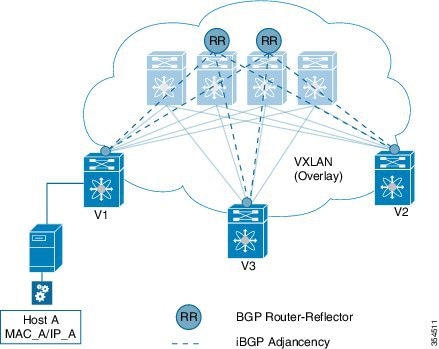Introducing IP Fabric Overlays (VXLAN)
Motivation for an overlay
An overlay is a dynamic tunnel that transports frames between two endpoints. In a switch-based overlay, the architecture provides flexibility for spine switches and leaf switches.
-
Spine switch table sizes do not increase proportionately when end hosts (physical servers and VMs) are added to the leaf switches.
-
The number of networks/tenants that can be supported in the cluster can be increased by just adding more leaf switches.
How this is achieved is explained in detail later.
 Note |
|
VXLAN as the overlay technology for the Programmable Fabric solution
VXLAN is a MAC in IP/UDP overlay that allows layer 2 segments to be stretched across an IP core. All the benefits of layer 3 topologies are thereby available with VXLAN including the popular layer-3 ECMP feature for efficient traffic spread across multiple available paths. The encapsulation and decapsulation of VXLAN headers is handled by a functionality embedded in VXLAN Tunnel End Points (VTEPs). VTEPs themselves could be implemented in software or a hardware form-factor.
VXLAN natively operates on a flood-n-learn mechanism where BU (Broadcast, Unknown Unicast) traffic in a given VXLAN network is sent over the IP core to every VTEP that has membership in that network. There are two ways to send such traffic: (1) Using IP multicast (2) Using Ingress Replication or Head-end Replication. The receiving VTEPs will decapsulate the packet, and based on the inner frame perform layer-2 MAC learning. The inner SMAC is learnt against the outer Source IP Address (SIP) corresponding to the source VTEP. In this way, reverse traffic can be unicasted toward the previously learnt end host.
- Scalability — VXLAN provides Layer-2 connectivity that allows the infrastructure that can scale to 16 million tenant networks. It overcomes the 4094-segment limitation of VLANs. This is necessary to address today’s multi-tenant cloud requirements.
-
Flexibility — VXLAN allows workloads to be placed anywhere, along with the traffic separation required in a multi-tenant environment. The traffic separation is done using network segmentation (segment IDs or virtual network identifiers [VNIs]).
Workloads for a tenant can be distributed across different physical devices (since workloads are added as the need arises, into available server space) but the workloads are identified by the same layer 2 or layer 3 VNI as the case may be.
-
Mobility — You can move VMs from one data center location to another without updating spine switch tables. This is because entities within the same tenant network in a VXLAN/EVPN fabric setup retain the same segment ID, regardless of their location.
Overlay example:
The example below shows why spine switch table sizes are not increased due to VXLAN fabric overlay, making them lean.
VM A sends a message to VM B (they both belong to the same tenant network and have the same segment VNI). ToR1 recognizes that the source end host corresponds to segment x, searches and identifies that the target end host (VM B) belongs to segment x too, and that VM B is attached to ToR2. Note that typically the communication between VM A and VM B belonging to the same subnet would first entail ARP resolution.
ToR1 encapsulates the frame in a VXLAN packet, and sends it in the direction of ToR2.
The devices in the path between ToR1 to ToR2 are not aware of the original frame and route/switch the packet to ToR2. .
ToR2 decapsulates the VXLAN packet addressed to it. It does a lookup on the inner frame. Through its end host database, ToR2 recognizes that VM B is attached to it and belongs to segment x, forwards the original frame to VM B.

-
VXLAN semantics are in operation from ToR1 to ToR2 through the encapsulation and decapsulation at source and destination VTEPs, respectively. The overlay operation ensures that the original frame/packet content is not exposed to the underlying IP network.
-
The IP network that sends packets from ToR1 to ToR 2 based on the outer packet source and destination address forms the underlay operation. As per design, none of the spine switches need to learn the addresses of end hosts below the ToRs. So, learning of hundreds of thousands of end host IP addresses by the spine switches is avoided.
Learning of (hundreds of thousands of) end host IP and MAC addresses
-
End hosts’ information is available to the attached ToR via First Hop Protocols such as ARP/ND/DHCP etc., when a new bare-metal server or VM is attached.
-
End host to ToR mapping information for each ToR is shared with every other ToR using BGP via a route reflector.
-
Specifically, within BGP, the EVPN address family is employed to carry MAC and IP address information of the end hosts along with other information such as the network and tenant (aka VRF) to which they belong. This allows optimal forwarding of both layer-2 and layer-3 traffic within the fabric.
-
VMs belonging to the same tenant might be many hops apart (though assigned with the same segment ID/VNI), and there might be frequent movement and addition of end hosts. When a new VM comes up or is moved between ToRs, the information is instantly updated into BGP by the detecting ToR thereby ensuring that the updated reachability information is also known to every other ToR.
-
In order to accurately route/switch packets between end hosts in the data center, each participating ToR in a VXLAN cluster must be aware of the end hosts attached to it and also the end hosts attached to other ToRs, in real time.
VXLAN-EVPN fabric — The overlay protocol is VXLAN and BGP uses EVPN as the address family for communicating end host MAC and IP addresses, so the fabric is referred thus.
More details for MP-BGP EVPN are noted in the Fabric Overlay Control-Plane (MP-BGP EVPN) section









 Feedback
Feedback